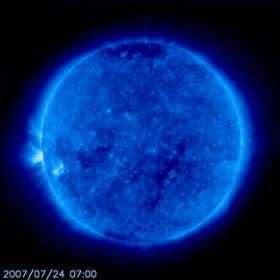The Sun Loses its Spots

While sidewalks crackle in the summer heat, NASA scientists are keeping a close eye on the sun. It is almost spotless, a sign that the Sun may have reached solar minimum. Scientists are now watching for the first spot of the new solar cycle to appear.
The 11 year long solar cycle is marked by two extremes, solar minimum and solar maximum. Solar minimum is the period of least solar activity in the solar cycle of the sun. During this time sunspot and solar flare activity diminishes, and often does not occur for days at a time.
When spots begin to appear on the sun once again, scientists know that the sun is heading into a new season of extreme solar activity. At the cycle's peak, solar maximum, the sun is continually peppered with spots, solar flares erupt, and the sun hurls billion-ton clouds of electrified gas into space.
Solar maximum is often compared to the hurricane season here on Earth. Violent solar events, like flares and coronal mass ejections, are the hurricanes of space weather. These solar storms are capable of wreaking havoc with satellites, power grids, and radio communication, including the Global Positioning System.
NOAA's Space Environment Center, Boulder CO, forecasts that the next solar cycle should begin in March 2008 and should peak in late 2011 or mid 2012.
Source: NASA





















